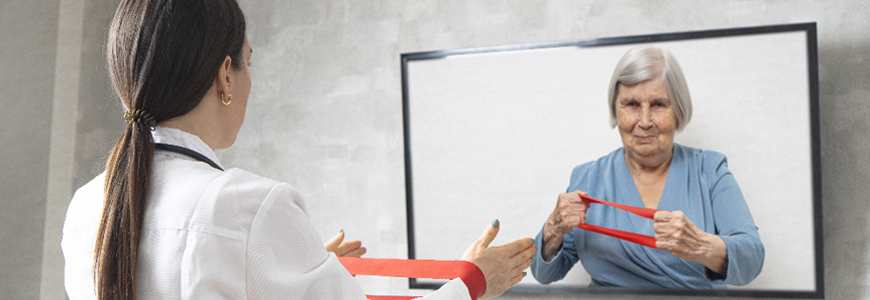The COVID-19 pandemic has highlighted the need for reliable self-examination to assist in orthopaedic telehealth appointments, but how does the diagnostic accuracy of a telehealth visit compare with traditional, in-person clinical examination?
Duke researchers compared the two methods in detecting common shoulder pathology—specifically rotator cuff tears in adults older than age 40 with atraumatic shoulder pain. An August 2020 study published in the Journal of Shoulder and Elbow Surgery found that the diagnostic effectiveness of the two examinations was almost identical, indicating noninferiority of the physician-guided, patient-performed telehealth assessment.
Study participants underwent both traditional shoulder clinical examination and simulated telehealth-based assessment in the same visit by two separate assessors, and the order in which the exams were performed was randomized. Analogous tests of movement and strength were used in both the traditional and telehealth-based approaches, and MRI was used as a reference standard.
Jocelyn Ross Wittstein, MD, a Duke sports medicine orthopaedic surgeon and the study’s principal investigator, explains that the study of 62 patients with no prior shoulder surgery or advanced imaging showed higher agreement between telehealth and traditional clinical examination maneuvers that are less “hands on” and lower agreement for maneuvers where the clinician would typically need to do more manipulating of the shoulder themselves. More importantly though, the two exam platforms showed equivalent accuracy in detecting rotator cuff tears.
“There is certainly a learning curve to shoulder telehealth,” Wittstein adds. “With some creativity and guidance, we are able to teach the patient how to perform an exam on themselves in a way that is meaningful to the provider deciding what the next step in management is.”
To make it easier for patients to complete the maneuvers, Wittstein and her colleagues created video demonstrations that participants watched in advance of the telehealth exam. Wittstein notes that assessing passive motion in the shoulder is trickier in the telehealth setting than checking active motion because the provider isn’t able to move a patient’s arm for them. She adds that there are many ways for patients to self-assist during a telehealth assessment of even passive motion, such as using a yard stick or cane and the uninvolved arm to assist with the range of motion.
Importance of this research
Rotator cuff tears are one of the most common causes of atraumatic shoulder pain in people over the age of 50, but many patients lack access to shoulder experts. Wittstein explains that these efforts to study the accuracy of telehealth examinations aim in part to increase critical access to subspecialty orthopaedic care, especially for those in rural communities, those with other comorbidities, and those who are immunocompromised. There are economic savings to patients as well, who are then able to miss fewer workdays and save on the cost of travel with telehealth access, she adds.
“Research like this helps ensure patients get the help they need when they need it without compromising their care,” Wittstein notes. “Through our telehealth offerings at Duke, we are able to offer high quality, meaningful interactions between the patient and the provider, which gives the patient a good initial plan for their shoulder condition.”
While the telehealth visit may necessitate an in-person follow-up visit, depending on the patient’s condition, “this research shows that it’s a good initial first step to help provide patient care that's high quality without necessitating exposure,” she adds. “A lot of times, you can take the first step in management, whether that be some over-the-counter medications or physical therapy referral for home exercises.”

Expanding findings to other joints
Wittstein says that while additional research is needed, the applications of these findings goes beyond just the rotator cuff. Richard C. Mather III, MD, MBA, a Duke orthopaedic surgeon and hip specialist, has done a similar study on the accuracy of a traditional clinical examination versus a self-administered clinical exam for detecting femoroacetabular impingement syndrome. A collaborative effort with Duke foot and ankle specialists is also underway to research the accuracy of telehealth for certain foot and ankle conditions.
“This research has encouraged other subspecialists to raise the bar in terms of what can be offered at Duke in terms of telehealth options,” Wittstein says. “There is a team effort underway across Duke Orthopaedics to make our telehealth offerings really outstanding—not just in a couple of subspecialized divisions, but across the entire department.”
